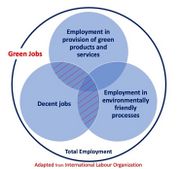BaCCC/Module 4/Lesson 3/Part 1
Contents
Module 4, Lesson 3: Sustainable Green and Blue Jobs for You, Part 1
Introduction
After introducing you to the definition of green (and blue) economies, this lesson talks about green and blue jobs in the world. You will learn how jobs in different sectors can be “greened” so that they contribute to climate change mitigation and a sustainable world. It will also discuss green jobs that are available – or should be available – as well as which jobs will have to be phased out as we drastically lower our carbon emissions.
(You can adjust the playback speed and/or turn on subtitles/captions.)
If you have trouble accessing the video, a summary is available below.
H5P Object Parameters
The H5P parameters below will be replaced by the actual H5P object when it's rendered on the WordPress site to which it's been snapshotted.
Terminology
The following terms are important in understanding the science behind climate change. If you want to remember them, write their meanings in your learning journal as you encounter them in the course content.
- blue economy
- green economy
What are “green” and “blue” jobs?
Green jobs (sometimes called green-collar jobs, sustainability jobs or eco-jobs) and blue jobs are decent jobs that contribute to a sustainable economy by preserving or restoring the environment on land (green jobs) or in oceans and coastal areas (blue jobs), be they in traditional sectors, such as manufacturing and construction, or in new, emerging green or blue sectors, such as renewable energy, energy efficiency and sustainable marine careers.
If you have trouble accessing the video, a summary is available below.
H5P Object Parameters
The H5P parameters below will be replaced by the actual H5P object when it's rendered on the WordPress site to which it's been snapshotted.
If you have trouble accessing the video, a summary is available below.
H5P Object Parameters
The H5P parameters below will be replaced by the actual H5P object when it's rendered on the WordPress site to which it's been snapshotted.
If you have trouble accessing the video, a summary is available below.
H5P Object Parameters
The H5P parameters below will be replaced by the actual H5P object when it's rendered on the WordPress site to which it's been snapshotted.
If you have trouble accessing the video, a summary is available below.
H5P Object Parameters
The H5P parameters below will be replaced by the actual H5P object when it's rendered on the WordPress site to which it's been snapshotted.
If you have trouble accessing the video, a summary is available below.
H5P Object Parameters
The H5P parameters below will be replaced by the actual H5P object when it's rendered on the WordPress site to which it's been snapshotted.
(You can adjust the playback speed and/or turn on subtitles/captions.)
If you have trouble accessing the video, a summary is available below.
H5P Object Parameters
The H5P parameters below will be replaced by the actual H5P object when it's rendered on the WordPress site to which it's been snapshotted.
If you have trouble accessing the video, a summary is available below.
H5P Object Parameters
The H5P parameters below will be replaced by the actual H5P object when it's rendered on the WordPress site to which it's been snapshotted.
Blue jobs (water is “blue”) are based on coastal and water management industries that focus broadly on water infrastructure and flood mitigation, including a range of investments related to coastal protection and restoration. Among the varied jobs involved with large water management projects, some of the largest in terms of employment are engineers who design infrastructure projects and building trades occupations that implement their construction.
These categories of green and blue jobs are not mutually exclusive. For example, wetland restoration occupations, such as hydrologists, machine operators, planners, and geographic information systems technicians, are all categorized as both “blue” and “green.” As rough approximations, both encompass a wide range of jobs in different industries. The common thread is that blue-green jobs are engaged in the work of making the region’s environment, economy, and communities more resilient and sustainable. — Amy Teller and Robert Habans (2022), Toward an Equitable Blue-Green Economy: Skills in Water and Green Jobs
For the International Labour Organization, green jobs are all those jobs that fall in the dashed areas in the diagram below.

Note that “decent jobs” are those that pay a decent wage and in which workers are treated respectfully.
| “ | A decent job involves opportunities for work that are productive and that deliver a fair income; provides security in the workplace and social protection for workers and their families; offers better prospects for personal development and encourages social integration; gives people the freedom to express their concerns, to organize and to participate in decisions that affect their lives; and guarantees equal opportunities and equal treatment for all. | ” |
| —Snežana Radovanović, Local Assembly of Soko Banja, The Green Jobs Programme of the ILO | ||
The Green Jobs Programme of the ILO[1]
References
- ↑ Radovanović, S. n.d. The Green Jobs Programme of the ILO

